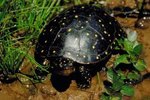
Snapping turtles inhabit both freshwater and brackish waters from southern Canada to the Gulf, and from the east to the Rocky Mountains. Reaching up to 3 feet in diameter, they need more land and water than other turtle species. They typically avoid people and should not be approached, picked up or hand-fed. But inviting them onto your property, assuming you have enough of it, is still beneficial.
A Big Yard and a Pond
Snapping turtles need 4 to 22 acres of habitat and access to a pond with a sandy or muddy bottom. If you have suitable property, you may already have a snapping turtle in residence. Unlike other species, snapping turtles spend most of their time in the water, basking for sunlight from the water's surface rather than the shore. In colder climates, they will simply hibernate over the winter months by burrowing under mud and leaves. Make sure to place ample leaf debris around the edge of the pond in the fall for overwintering.
Lure Them With Delicacies
Snapping turtles like to eat underwater, and they lie in wait for unsuspecting prey to waltz by before they reach out their long necks in a quick lunging motion. Their diet includes fish, spiders, frogs, birds, smaller turtles, insects, worms and small mammals -- but they also want some fresh plant matter. Inviting these smaller creatures into your yard will ensure a fresh supply of snapping turtle food. Wetlands naturally attract the majority of a snapping turtle's diet, but you can place bird feeders around the pond and keep natural plants growing in and around the water to assist.
Not the Worst Neighbors
The snapping turtle's diet will rid your yard of a lot of unwanted pests, and he may even feast on any dead animals he comes across. The shy creatures won't mess with swimmers, so they do not render a pond useless for recreation. And in spite of their powerful jaws, they do not bite if stepped on; they would rather avoid you at all costs under normal circumstances.
They're Not Pets
These creatures get quite large -- over 45 pounds -- and are not easily removed once they settle in. They shouldn't be picked up, especially the large ones. They can also live up to 40 years, so be prepared for a long relationship. They have been known to decimate the fish population in some privately stocked ponds. While they're typically shy, mating season in June and July brings out aggressive behavior -- but only if the vulnerable turtles are provoked. This continues into egg-laying, so avoid any turtle on the prowl for a significant other or laying a clutch of eggs. Children and pets should be kept clear of snapping turtles found outside of the pond. Wild turtles do not carry the salmonella virus that pet turtles can transmit, but you should wash your hands anyway, after handling a turtle, particularly if you'll handle a baby, too.
References
Resources
- Fairfax County Public Schools: Common Snapping Turtle -- Chelydra Serpentina
- New York Department of Environmental Conservation: Snapping Turtle
- Cornell University: Wild Things in Your Woodlands -- Common Snapping Turtle
- Wisconsin Department of Natural Resources: Amphibian and Reptile FAQ
- Tortoise Trust: Snapping Turtles
Photo Credits
-
Jupiterimages/Photos.com/Getty Images
Writer Bio
Lori Lapierre holds a Bachelor of Arts and Science in public relations/communications. For 17 years, she worked for a Fortune 500 company before purchasing a business and starting a family. She is a regular freelancer for "Living Light News," an award-winning national publication. Her past writing experience includes school news reporting, church drama, in-house business articles and a self-published mystery, "Duty Free Murder."



